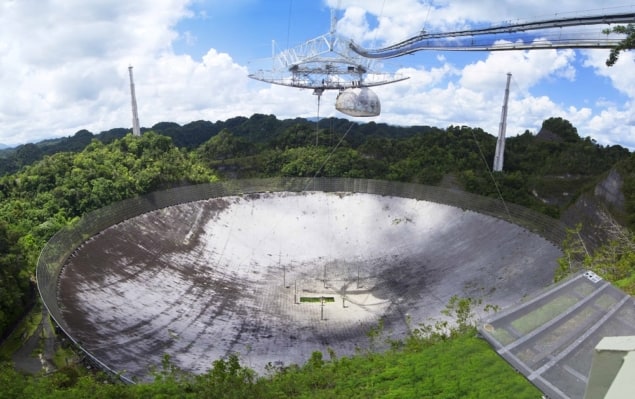
Astronomers at the iconic Arecibo Observatory in Puerto Rico have revised their plans for a telescope to replace the original facility, which dramatically collapsed in 2020. The so-called Next Generation Arecibo Telescope (NGAT) would, if funded, involve building a phased array of small parabolic antennas to carry out pioneering research to maintain the island’s position at the forefront of astronomy.
The Arecibo Observatory, which first opened in 1963, is located in a natural bowl and was used for research into radio astronomy, planetary and space studies as well as atmospheric science. But on 1 December 2020 the radio telescope’s suspended platform – with its Gregorian dome focus and a plethora of instrumentation – fell after multiple suspension cables failed. The 900-tonne platform crashed into the 305 m dish, which lies almost 140 m below, destroying parts of it.
Despite the damage, the National Science Foundation (NSF), which funds the observatory, decided it would not close the site. Early this year, it extended an agreement to maintain and operate the collapsed telescope from March until the end of September “to ensure a smooth transition to the next phase”. “NSF [will] work with a small business to handle the day-to-day operations and maintenance of the Arecibo site, ensuring maximal flexibility for the use of the site into the future,” says an NSF spokesperson.
The NSF is also considering proposals to convert the facility into a Arecibo Center for STEM Education and Research. Meanwhile, the site continues to support research. As well as analysing historic data and transferring them from the site to the Texas Advanced Computing Center, scientists are still working with Arecibo’s ancillary equipment, which includes a lidar facility, optical laboratory and a 12 m radio antenna.
But in 2021 Anish Roshi, the observatory’s head of radio astronomy, unveiled a proposal to replace the telescope with a phased array of 1112 parabolic dishes, each 9 m in diameter, placed on a tiltable, plate-like structure. This new facility, with an estimated cost of $454m, would provide the same collecting area as a 300 m parabolic dish. “It would have a much wider sky coverage and would offer capabilities for radio astronomy, planetary, and space and atmospheric sciences,” Roshi says. “It would be a unique instrument for doing science that competitive projects couldn’t do.”
Downsize me
A lack of support from the NSF, however, has forced researchers to go back to the drawing board to make the array “more cost-effective both for construction and operation” as Roshi puts it. In the revised proposal, submitted to arXiv late last month, his team now envisions a downsized version of the original concept. Dubbed NGAT-130, it would consist of 102 dishes, each 13 m in diameter, that would in combination have a collecting area equivalent to a single 130 m dish.
“You can make a very competent telescope even with the reduced collecting area that could study solar coronal emissions, space weather and [hydrogen] intensity mapping, for example,” Roshi told Physics World. “We tried to do something more cost-effective, but appealing internationally.” How the Arecibo Observatory created a scientific legacy for Puerto Rico
Roshi concedes that his team has no cost estimates for its revised design. “We need to make a robust cost model for the mechanical structure and transmitters,” he says. “Both these require modelling and prototyping.”
The NSF will not comment on the new proposal as it “does not speculate on awards that have yet to be reviewed”, according to a spokesperson. To reach that stage, Roshi says they aim to create a “structure” by August, in which engineers and scientists begin work on modelling, designing and prototyping NGAT-130.



